On Location: At CounterPunch Studios, actors’ digital doubles come to life

- Share via
Like a scene in a science fiction movie, actor Robbie Amell stands inside a giant aluminum globe, staring into hundreds of bright lights and a half-dozen cameras pointed at him.
“Brows up, eyes open, take one” a technician tells Amell, who promptly arches his eyebrows and makes big bug eyes.
“Three, two, one,” the technician says. The lights flash, and cameras click in machine-gun-fire succession to capture Amell’s astonished expression.
“Feels like ‘A Clockwork Orange,’” says Amell, referring to the famous scene in the movie in which Alex (Malcolm McDowell) is strapped to a chair and his eyes are pried open while he is forced to watch violent scenes.
Over the next 45 minutes, the cameras recorded some 30 facial expressions from the young Canadian actor, who plays a superhero in the upcoming CW TV series “The Flash.”
The images recorded in the cameras would provide the raw microdata — right down to the pores — for workers at CounterPunch Studios to create a realistic-looking digital double for Amell.
“He’ll have a pretty good arc in the series,” says Armen Kevorkian, a senior visual effects supervisor with post-production firm Encore Hollywood who is working on the series. “We need a very convincing digital double of him to put him in places where he can fly and do different things.”
Brentwood-based CounterPunch has built a growing business by creating realistic-looking digital faces of actors — including some who are deceased — for video games, Bollywood movies, theme parks and now TV shows such as “The Flash,” which premieres Oct. 7.
CounterPunch creates its digital humans from photographs and works with Burbank-based LightStage to scan faces, like the ones for “The Flash.”
Once the scan is complete, it can take six to eight weeks to fashion a realistic-looking digital head. Using the data of the facial expressions, modelers build a virtual mold of the face and stitch together the various expressions to develop a kind of digital puppet that can produce multiple faces depending on what the scene requires.
“What we have to do is go and build the character inside the head,” said Andrew Egiziano, owner of CounterPunch.
The technology to create digital doubles has been around for several years, but its use has been limited. One reason is the so-called uncanny valley effect, when viewers find near-human images unsettling.
But in recent years the computer animation technology has improved to make facial features and images more realistic — and less creepy.
Until recently, such technology was considered too expensive for television. Enter CounterPunch, which developed a proprietary software to substantially lower the costs of creating fake heads.
The virtual heads cost anywhere from $8,000 to $200,000 to build, depending on the level of detail required. Still, that’s down from the half a million that it used to cost five years ago, Egiziano said.
Creating so-called virtual actors is a touchy subject in Hollywood. “Avatar” Director James Cameron’s groundbreaking use of “performance capture” technology stirred debate about whether such technology would make actors obsolete.
Egiziano doesn’t see digital actors replacing the real ones in the foreseeable future.
“Even if technology can grow to the point where actors are extraneous, you still want the real actors,” he said. “You want to be able to relate to a character, and it’s hard to relate to a clone.”
Launched in 2011, CounterPunch Studios is run by the former production team of Image Metrics, the company best known for its visual effects work on the aging face of Benjamin Button, the character played by Brad Pitt in the 2008 fantasy drama.
Image Metrics also created a digital image of legendary basketball coach John Wooden in a 2010 commercial for the NCAA, and worked with the USC Institute for Creative Technologies to help create a widely viewed double of actress Emily O’Brien.
Egiziano, Image Metrics’ director of production, launched his own studio when the owners of the company decided to exit the production business.
Initially, CounterPunch focused on creating faces and bodies for characters in video games. Then Bollywood studios took note. They turned to CounterPunch to create digital doubles of aging Bollywood stars to make them look younger, or perform death-defying stunts that would be too difficult and risky to do practically.
For one movie, billed as an Indian version of Beowulf, CounterPunch created the digital heads of nine characters, one of whom was deceased.
CounterPunch turned its first profit last year thanks to the growing Bollywood business. Annual sales will reach $4 million this year, double the level from 2012, Egiziano said.
The company also is working on an undisclosed TV series for Disney.
CounterPunch has created digital doubles of LeBron James (for his Web series) and Frank Sinatra. Another project, a theme park in Jordan, involves creating virtual replicas of Leonardo da Vinci and Albert Einstein.
“They want to bring people back to life,” Egiziano said.
More to Read
Sign up for The Envelope
Get exclusive awards season news, in-depth interviews and columnist Glenn Whipp’s must-read analysis straight to your inbox.
You may occasionally receive promotional content from the Los Angeles Times.







